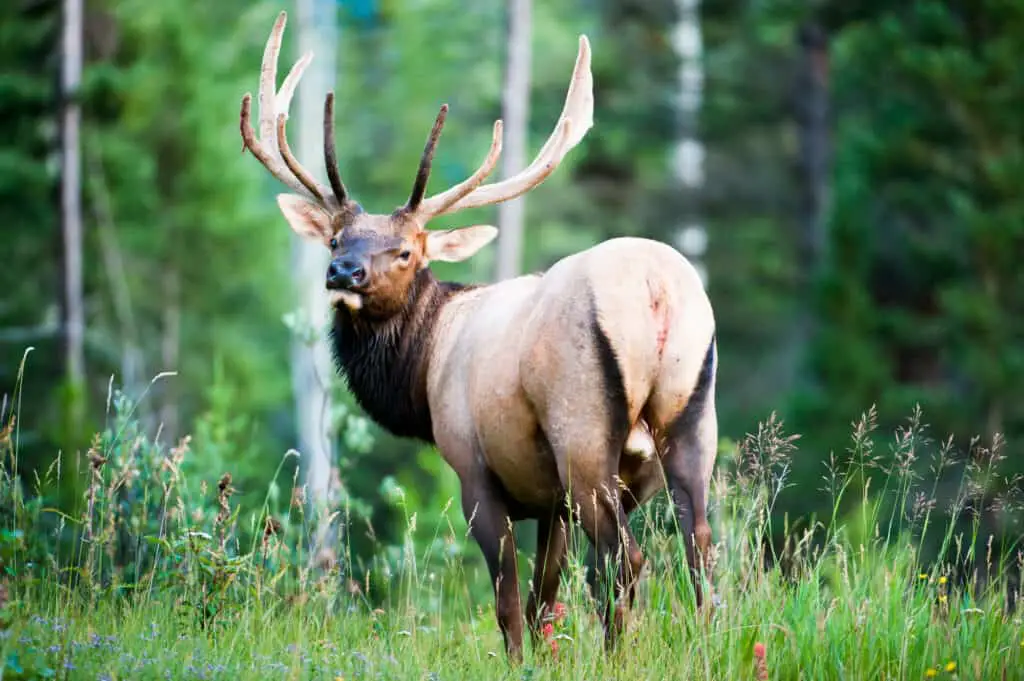Visitors throng to see the majestic elk that make the Rocky Mountain National Park their home. With 600-800 elk in RMNP, we’ve rarely had a day in the park where we haven’t encountered elk. Although I do have to share that sometimes we found them in unexpected places. The most important tip is to keep an eye out! But there are definitely places where elk are more likely to be found.
In this guide, we’ll take you through the best elk viewing spots in Rocky Mountain National Park. We’ll share where you can catch a glimpse of these magnificent animals up close. From the best times to visit to the best trails to hike, we’ve got you covered.
Best Places to See Elk in Rocky Mountain National Park
Generally elk can be found in low-level meadows, usually in open fields near tree lines. Here are some of the best elk viewing spots we’ve found in the park:
- Moraine Park – During the fall season, large herds of elk can be seen grazing in the meadows. Other seasons you’ll see small groups of cows grazing along the waterways. The best time to view elk in Moraine Park is early in the morning or late in the afternoon.
- Horseshoe Park – During the fall season, the elk migrate to Horseshoe Park in search of food and shelter. The best time to view elk in Horseshoe Park is early in the morning or late in the afternoon.
- Upper Beaver Meadow – The meadow provides a great open space for elk to graze and interact with each other. The best time to view elk in Upper Beaver Meadows is early in the morning or late in the afternoon.
- Kawuneeche Valley – Located on the west side of the park and is a great spot to view elk year round because of the lush grasses and waterways. In winter the elk migrate to this area in search of food and shelter. The best time to view elk in Kawuneeche Valley is late in the afternoon.
There’s also a small herd of elk that made the town of Estes Park their home. In town you can find them on the golf course or even walking the streets.
During the summer many elk move to higher elevations so watch for them as you drive along Trail Ridge Road. Although they can be found near the road, we usually see them in meadows in the distance so bring along a pair of compact binoculars.
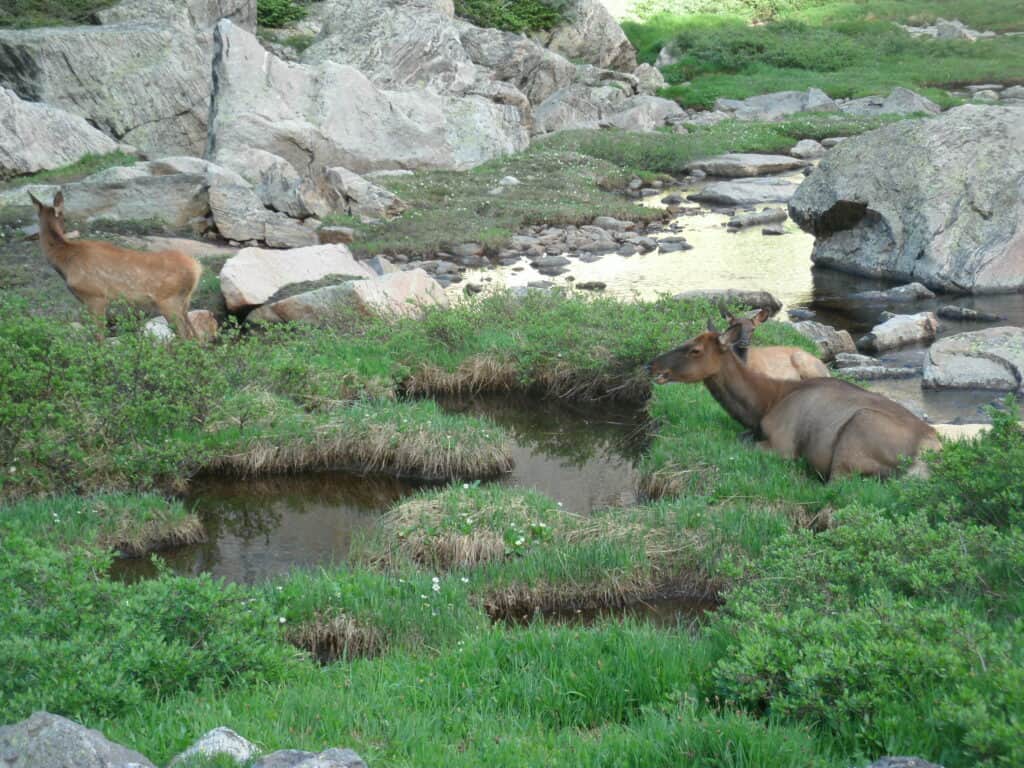
Hiking Trails for Elk Viewing
Hiking is a great way to get up close and personal with elk in Rocky Mountain National Park. We often encounter elk while hiking in Rocky Mountain National Park. We encountered this mama and her calf while hiking to Sky Pond. In the summer months, when you are most likely to be out for a hike, watch for elk around waterways. Here’s several good trails to try for elk watching:
Cub Lake and Fern Lake Trails
Cub Lake Trail is a 6.0-mile round trip hike when combined with Fern Lake for a loop hike. It takes you through meadows and forests. The trail is known for its stunning views of the mountains and the opportunity to view elk up close.
Alberta Falls to Sky Pond
The hiking trail between Alberta Falls and Sky Pond is a great place to see elk. The first mile, to Alberta Falls is too busy for elk to hang around long. But if you hike past that it’s highly likely you’ll encounter a variety of wildlife including elk without hiking all the way to Sky Pond.
Alpine Ridge Trail
The Alpine Ridge Trail starts behind the Alpine Visitor’s Center. It’s a common place for elk to gather during the summer months. Be careful though, this is a very high elevation and can be hard on your system if you haven’t acclimated to the altitude.
East Inlet Trail
East Inlet Trail is a total of 18 miles round trip, but don’t feel like you need to hike the full distance to see elk. It’s a great hike that starts near Grand Lake. The trail is known for its stunning views of the mountains and the opportunity to view elk up close.
Seeing Elk Calves in Rocky Mountain National Park
New babies are born in June, but their mama’s keep them hidden in the tall grass for a few weeks so it’s usually July before you see many young elk. The youngsters will generally be with a herd of other mothers and babies, often moving to higher meadows for fresh alpine grass.
Where Can You See Bull Elk?
Seeing a mature bull elk in Rocky Mountain National Park is quite the experience. They are 700-pound massive creatures with antlers that can span up to 50 inches. Observing them in their natural habitat is something to remember for a lifetime.
However, senior bull elk are elusive and more difficult to find during the spring and summer months, because they are out in remote meadows or high alpine slopes. They tend to be more cautious than the cows, feeding at night in areas humans are unlikely to visit. You might hear them bugle back and forth with each other at this time of year.
You will likely see younger bulls in bachelor groups during the summer in the same meadows you find cows and calves. And very young bulls will often stay with their mother’s herd for a couple of years.
If your goal is to see one of the giant mature bull elk then come during the rut, which is the breeding season. Rut in Rocky Mountain National Park is primarily during October. During the rut, the dominant bulls gather their cows into “harems” to protect them from the attention of competing bulls.
Because their testosterone is so high and they have one thing on their mind, they are not as cautious as they are the rest of the year and are more likely to be seen in open spaces tending to “their” cows. Fall is also a popular time to enjoy Rocky Mountain National Park fall colors so it’s a great time to visit the park.
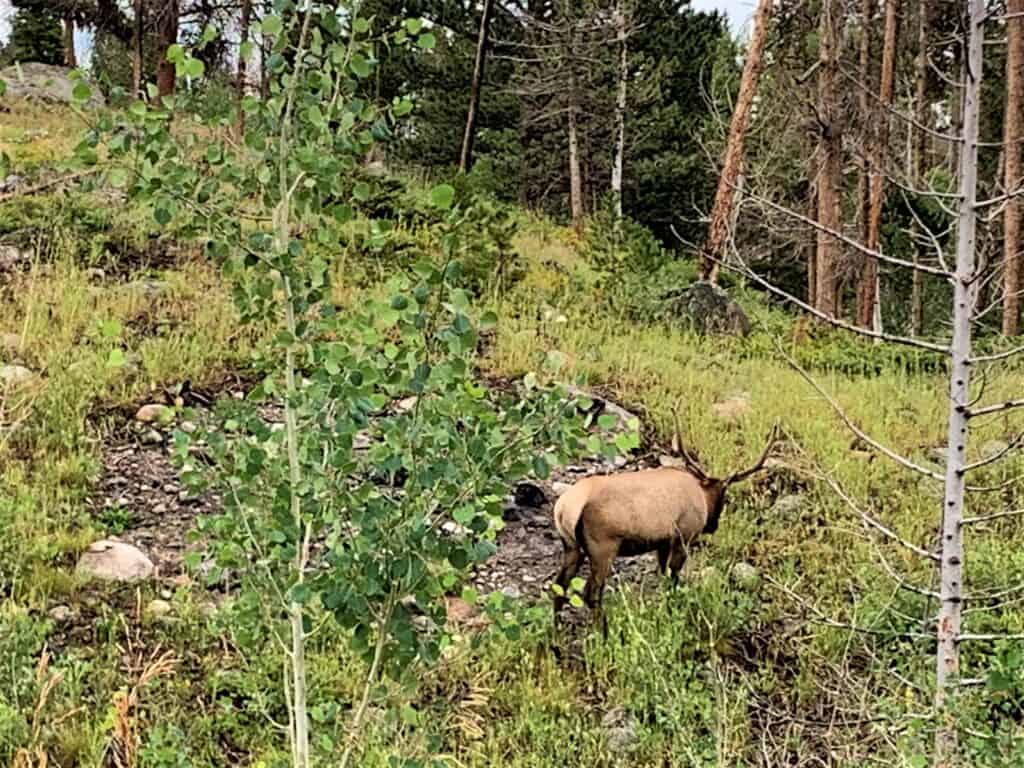
Best Seasons for Elk Viewing
The best time to view elk in Rocky Mountain National Park is from mid-September to mid-October. Because elk are in rut in the fall they are moving around more than any other time of year. Bull elk are much more focused on getting the attention of the female elk than on people they tend to be in the open fields and waterways the ladies prefer. That makes them much easier to spot.
While fall is the peak season for elk viewing, the winter months also offer great opportunities to spot these creatures. Both male and female elk tend to migrate to lower elevations during the winter months in search of food and shelter. This makes them more visible along roads and in open areas, making for easier viewing. This increases your chances of spotting elk along roadways or hiking trails.
Female elk can be seen throughout the park and in towns near Rocky Mountain National Park all year long. And in late summer you’ll often see them wandering around with their babies close by.
What is Rut?
Rut is the term used to mean they are actively mating. The bulls will battle each other for the right to breed. These battles involve loud bugling calls, charging, and the clashing of antlers. It’s pretty amazing to see. However, don’t get too close as these bulls have no fear of humans when their testosterone is peaking. They will hurt you too.
The Best time of Day to See Rocky Mountain National Park Elk
Elk are primarily nocturnal animals so the best time to see elk is in the early morning or early evenings when they are most likely to come out into the meadows to graze. We’ve had the most success an hour or so before sunset as the dew starts to settle in the meadows.
That doesn’t mean you can’t see elk during the day. It’s not unusual to discover small groups of elk roaming around the park. If you see cars pulled over to the side of the road it is often because elk are nearby so grab your camera. This is when I get the best “butt shots” of Rocky Mountain Elk because they are on the move and I tend to catch them moving away! Yes, a family joke that I am slow on the draw with the camera! So learn from my mistake and always be ready for that perfect shot!
Don’t Let the Planning Overwhelm You!

Plan your perfect trip to Rocky Mountain National Park!
Check out our complete digital Guide to Rocky Mountain National Park. This is written specifically for the first time visitor to make your trip planning easy! Over 90 pages of things to do and see on your adventure. Plus get pro tips for planning your adventure.
Start planning immediately with Digital Download!
Photography Tips for Capturing Elk in their Natural Habitat
It’s likely your dream to catch some amazing photos of elk during your visit to the park. I know it’s something we look forward to during every trip we make into the Rockies. Here’s a few tips:
- Use a Telephoto Lens – A telephoto lens will allow you to zoom in on the elk from a safe distance. Stay at least 25 yards away from elk when you encounter them.
- Use a Tripod – Even if you are taking photos with your iphone you can get great shots if you anchor your phone.
- Shoot in Good Light – Early morning and late afternoon are the best times to shoot photos of elk. The light is softer and more flattering compared to harsh mid-day light. Elk are also more active during these times.
- Be Patient – Elk are wild animals and can be unpredictable. Be patient and wait for the right moment to capture the perfect shot.
Fun Facts About Rocky Mountain National Park Elk
Why do Elk Bugle?
The bugle of the elk in Rocky Mountain National Park can be heard best in the fall during mating season. But the elk bugle is more complex than just a mating call. Elk Bugle for a variety of reasons. During the summer months, elk use their bugle to locate each other.
It’s not uncommon to hear male-to-male or male-to-female calls. This is a completely different sound than you hear in the fall when the males call to gather their females into their “harems”. And the most intriguing and loud bugle is the call between 2 males when defending or challenging a territory during mating.
Cows will also bugle, although their calls are not as famous as the deep sounds of the male during the rut. They bugle when in heat, make similar noises when giving birth and a lead cow will bugle to move the herd. Keep in mind that it is illegal to “call” an elk in the park, you need to allow them to follow nature.
How About Those Huge Elk Antlers
Like all members of the deer family, male elk grow a new set of antlers every year. The antlers start growing in the spring and reach full size by fall. The primary purpose of the antlers is related to mating. The size and health indicate to the females that the bull elk is a worthy mate, which helps attract her to his harem.
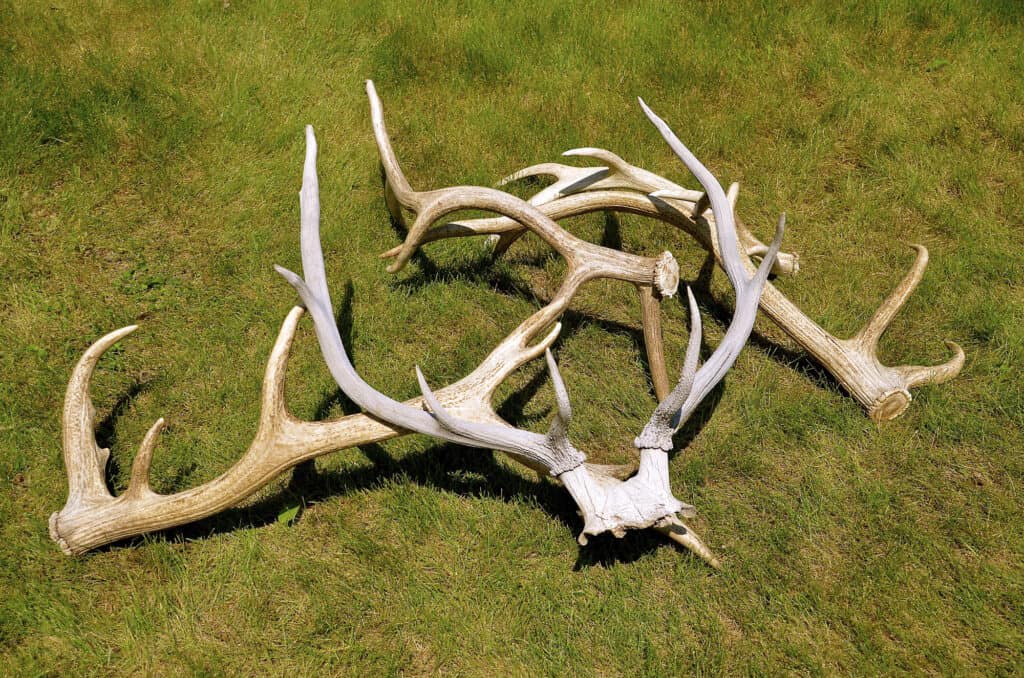
They are also used by males to spar over mating rights. It’s fairly common to catch a sparring match while observing elk in Rocky Mountain National Park during the rut if you patiently observe a herd.
According to the Fish and Wildlife Service, elk antlers can grow up to an inch a day and weigh over 40 pounds. Elk shed their antlers every winter. Note it is illegal to gather antlers in the park. A wide variety of small creatures gnaw on the sheds to get the nutrients stored in the bone. So if you find a pair of elk antlers, leave them lay where you found them to support the ecosystem.
What do Elk Eat in Rocky Mountain National Park?
Elk are herbivorous animals that spend most of their time grazing on plants grasses and flowering plants. That’s why you will find them in marshy meadows where grasses and wildflowers are plentiful. Or they climb to higher elevations as the summer gets warmer and dryer at low levels to find the cooler alpine ecosystem with vegetation they love so much.
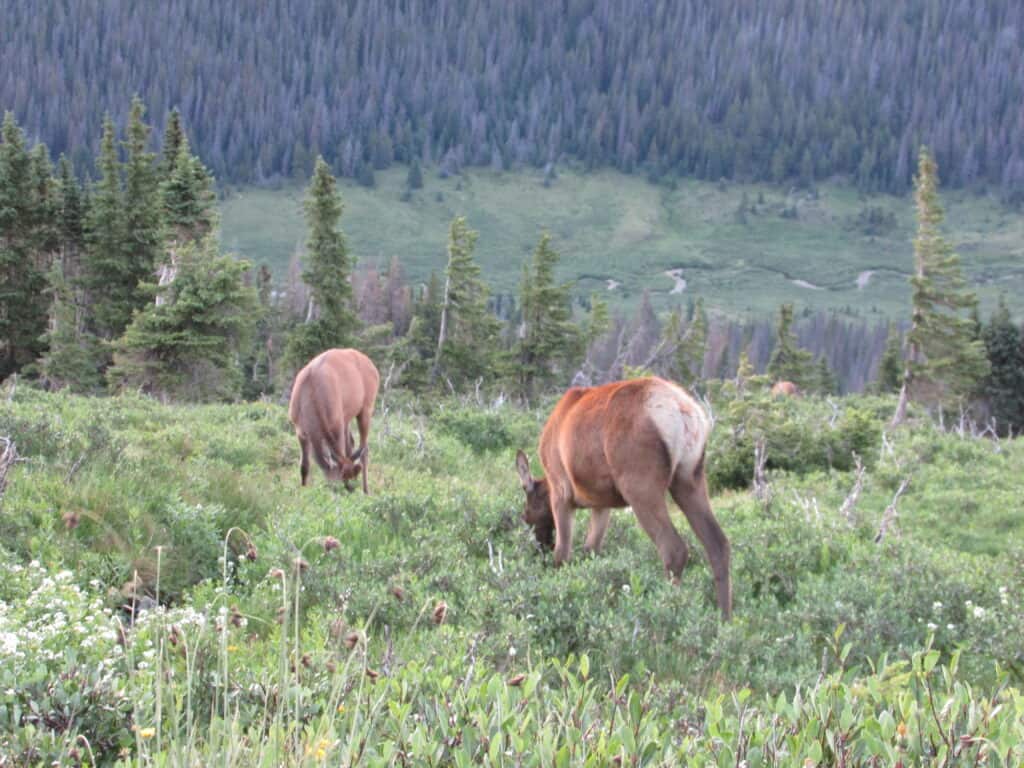
Winter months can be more challenging for elk since food becomes harder to find under snow cover. Elk will eat twigs, branches and tree bark when they can’t get to the grasses. They love to munch on the aspen that we also love for their amazing Rocky Mountain National Park fall colors.
That’s why you will see some areas of trees surrounded by tall fences in RMNP. These are areas of aspen and willow that need a chance to recover from elk overeating. The fences will be removed when the forested area is healthy again.
How Fast Do Elk Move?
Elk use their speed to evade predators, with the ability to run around 20-25 mph and have short bursts of 40-45mph. However you will notice that most of the time they just meander as they graze.
Elk Migration Patterns in Rocky Mountain National Park
Many elk in Rocky Mountain National Park migrate between different elevations throughout the year in search of the best food and shelter. During the summer months, they can often be found at higher elevations, The higher elevations provide cooler air and crisp alpine vegetation. As the temperatures drop in the fall, they will follow the snowfall to lower elevations to get away from the harsh winter conditions.
History of Elk in Rocky Mountain National Park
Once plentiful, by the end of the 19th century elk were almost non-existent in the park due to overhunting. In the early 1900s elk were moved from Yellowstone NP to Rocky Mountain National Park to repopulate the area.
Grizzly bear and wolf, both natural predators of the elk were reduced in the population at the same time. The result is the park currently maintains 600-800 elk in the park.
As you know the park is not a zoo, so there are no fences. Much of Rocky Mountain National Park is surrounded by National Forest so today’s elk herds cross those invisible lines regularly. And elk love sweet juicy grass and flowers so they often live in towns where they can find the treats they love in people’s yards and gardens.
Where Else Can Elk be Found in the United States?
You might be surprised to learn that there are wild elk populations in more states than not. 31 states have natural herds of elk with Colorado being the most populous. If you draw a line down the Rocky Mountain Range, most elk are found in the range and west of those mountains.
In the Eastern United States, the only significant population is around the Great Smoky Mountain National Park.
Tips for Viewing Elk Safely in Rocky Mountain National Park
Keep your distance
Remember the goal here is to observe elk in their natural habitat doing their natural thing. When people get too close, animals change their behavior. Don’t be “that guy”! Stay at least 25 yards from elk. That’s about the length of 2 semi-trucks nose to nose.
While the guideline is to stay at least 25 yards from elk, there are times you need to stay even further away. The most important rule is to be aware of how the elk are reacting to your presence. Bulls will express anxiety by pawing the ground, putting back their ears, or pointing their antlers at you. It’s obvious they are not happy you are in their space.
Cows generally will lay back their ears and stare at you when they feel uncomfortable by your presence. If she is all alone, she might be calving or have her calf nearby. Give the mama her space! If an elk appears distressed when you are observing move away. Reports of elk attacking someone are rare and are usually one of those stories where you have to ask yourself how someone could be so stupid to do that… like stand next to a rutting bull for a selfie.
Keeping your distance is primarily to protect the way of life for the elk. To allow them to live their life naturally so we can enjoy watching and photographing them in nature.
Hold your child’s hand. A child running into a herd to pet a baby elk might sound like a cute photo but is a disaster waiting to happen. Know that mama elk will do whatever it takes to protect her calf, wouldn’t you? So hold your child’s hand so they aren’t tempted to “play” with the elk.
Create a Non-Threatening Space for Wildlife Viewing
Elk will stay around longer if they feel safe. To help them ignore that you are watching them you can do a couple more things:
- Shut off your car engine and turn off your lights. Keep as quiet as possible, using soft voices to talk to each other. If you get out of your car, close the doors softly.
- Move pets away from elk. The scent of a dog alone will cause an elk to move away ruining the viewing experience for everyone. And nothing good will come of dog and elk encounter.
- Use binoculars and telephoto lenses to get a real close look. You should stay on the roadside and not enter the field to avoid disturbing their feeding.
Finding Other Wildlife in Rocky Mountain National Park
Bear, Big Horn Sheep, Coyotes, Mountain Lions and Moose are often spotted in the park. These animals a little more elusive. Your best bet is to always be aware of your surroundings and one might just wander by. You can learn more in our guides:
Don’t miss out on the opportunity to watch these amazing creatures. We hope this post has helped you learn more about how elk live in Rocky Mountain National Park and where to find them. Although fall is the perfect time for elk viewing, you will see them almost any time of year with a little patience. Good luck on getting the perfect elk photo!

